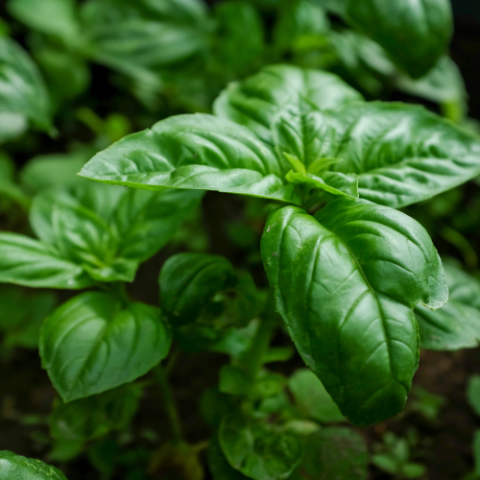Basil
Ocimum basilicum
History
Basil has a long and diverse history that spans across different cultures and regions. It originated in India, where it held sacred and revered status. In ancient Indian traditions, basil was associated with religious rituals, medicine, and folklore.
From India, basil spread to other parts of the world. It found its place in ancient Egypt, where it was used in embalming rituals and highly valued for its aromatic qualities. The herb then made its way to ancient Greece and Rome, where it became a symbol of love, protection, and hospitality.
Over time, basil’s culinary significance grew, and it became an integral ingredient in various cuisines, particularly in Mediterranean and Southeast Asian cooking. Its distinct aroma and flavor, often described as sweet and peppery with hints of clove and anise, add depth and freshness to a wide range of dishes, including salads, sauces, soups, and pesto.
In addition to its culinary allure, basil possesses medicinal properties. It has been utilized in traditional medicine systems, such as Ayurveda and traditional Chinese medicine, for centuries. Basil is believed to have antibacterial, anti-inflammatory, and antioxidant properties, among others.
Cultivating basil is relatively straightforward. It is an annual herb that thrives in warm climates, preferring well-drained soil and abundant sunlight. Basil can be grown from seeds or cuttings, and there are several varieties available, each with its unique characteristics. Popular cultivars include Genovese basil, Thai basil, lemon basil, and holy basil, each offering distinct flavors and aromas.
Basil holds cultural significance in different parts of the world. In some cultures, it is associated with love, protection, and good fortune. Basil plants are often grown in home gardens, used as decorative elements, and even believed to ward off evil spirits,
Source: https://usbasilconsortium.rutgers.edu/all-about-basil/basil-history-and-culture/
Medicinal Uses
- Bacterial Protection
- Blood sugar regulation
- Heart disease prevention
- Nausea
- Gut health
- Inflammation
- Skin Health
Recipe For Home
Roasted Tomato Basil Soup
Ingredients:
-
20 ounces cherry or grape tomatoes
-
¼ C olive oil
-
1 TBS fresh thyme leaves
-
salt and pepper, to taste
-
1 medium yellow onion thinly sliced
-
3 large garlic cloves thinly sliced
-
½ tsp red-pepper flakes
-
2 15oz cans white beans, drained and rinsed
-
1 ½ C broth or water
-
1 bunch fresh basil, sliced
Instructions:
- Heat the oven to 425 and line a baking sheet with tin foil. Toss the tomatoes with 1/4 cup oil and thyme; season well with salt and pepper. Roast tomatoes until they have collapsed and begin to turn golden around the edges, 20 to 25 minutes.
- When the tomatoes are almost done roasting, heat 2 tablespoons oil in a large (12-inch), deep skillet or Dutch oven over medium. Add the onion, garlic and red-pepper flakes and cook until the onion is softened and the garlic is fragrant, 4 to 5 minutes. Stir in the rinsed beans and broth and bring to a simmer. With the back of a spoon or spatula, gently smash about ½ cup of the beans so they slightly thicken the broth. If you want a thicker stew, crush some more of the beans. Season with salt and pepper.
- When the tomatoes are finished roasting, add them directly to the stew along with any juices that have been released. Simmer for 15-20 minutes more so the flavors come together and season to taste with salt. Stir in fresh basil. Serve with chopped fresh parsley
Source: https://creativelydelish.com/roasted-tomato-basil-soup/

